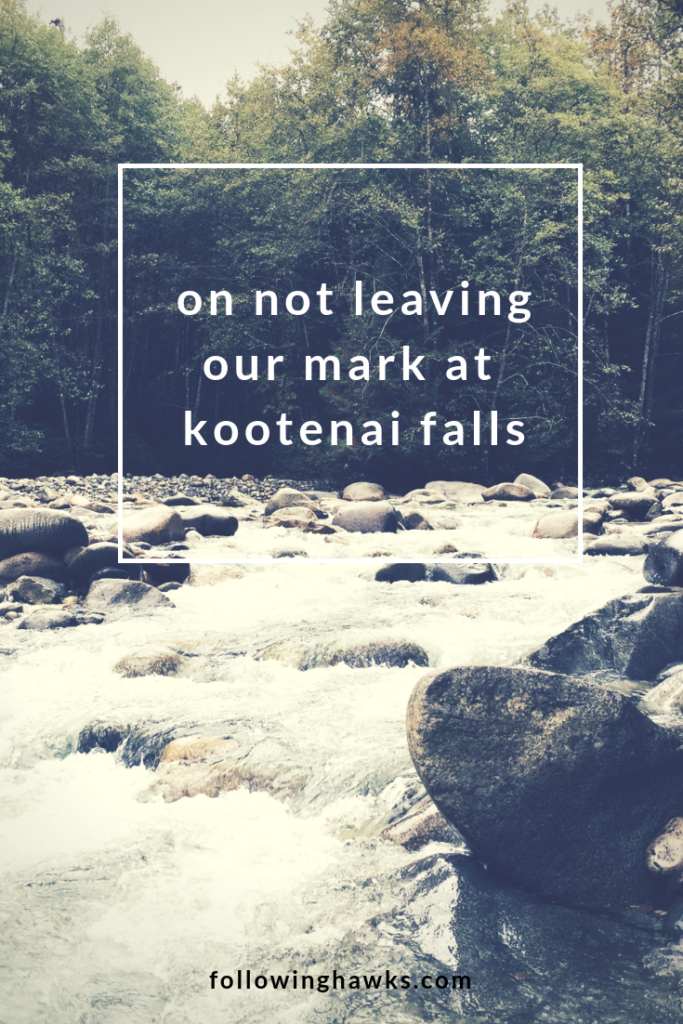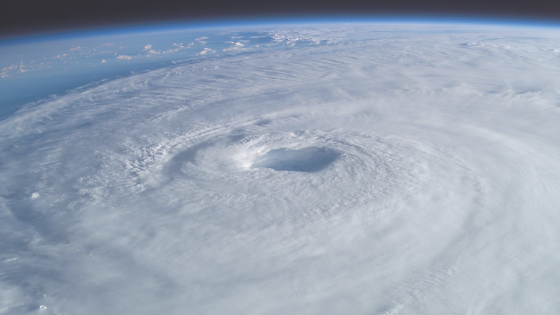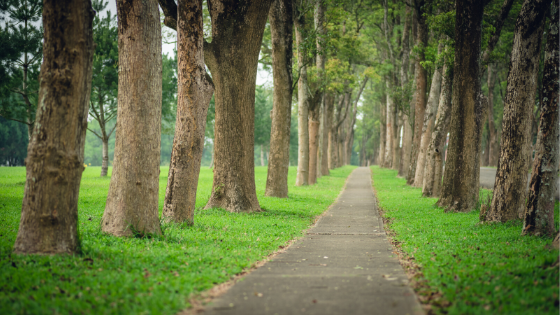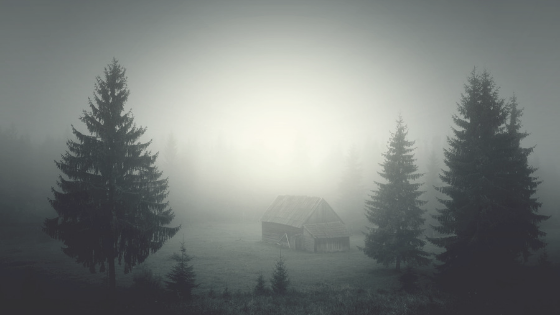I had anticipated sharing another story from the land this week, but then this story jumped to the front of the line. It's not that it's not a story from the land, but it feels just a bit different. So forgive the pause in the stories from Kentucky while I share one from my own backyard.
Kootenai Falls isn't quite in my backyard. It's about an hour and a half west of us, past the little town of Libby – who most certainly has its own story to tell being the site of what the government calls “the worst case of industrial poisoning of a whole community in American history” as a result of asbestos dust released into the air for decades from the local vermiculite mine.
I've only visited this area once before, four years ago, when we were out for a Sunday drive to explore the area and happened across it. That time, it was late in the day when we visited and we still had a long drive home, so when we had to choose between heading left on the trail to see the swinging bridge or to the right to see the falls, we chose the bridge and skipped the falls altogether.
On that trip, as soon as I saw the bridge I realized that I had dreamt about it the night before, which was a bit strange because I didn't know about it at the time.
In the dream I was frightened to cross the bridge because there was nothing to hang onto and a woman told me there would be plenty to hold on to, if I needed it. Since then, I haven't really thought about the bridge or the falls or visiting again anytime soon. Then suddenly, last Saturday night, it popped into my head and called me back. We decided to make the trip the next morning.
I wasn't sure why I needed to go, so when that happens, I stand in front of my (ever growing) altar of stones and feathers and oils and say….okay, who wants to go?!
My little singing bowl, gifted to me by a friend, jumped up and down, along with my lemurian seed crystal, neither of which I've spent much time connecting with since they came to me, and a bottle of Sacred Mountain essential oil, which I often use for channeling or meditation. It's a wonderful blend of Black Spruce, Ylang Ylang, Balsam and Cedarwood.
I packed them all up in my bag, along with a small blanket and my hat and gloves and we headed west for the falls.
Upon arriving at our destination, I stopped to read the large interpretive panels that have been installed to educate visitors on the flora and fauna and history of the area. I was immediately struck by the nearly complete exclusion of the native people in the area on the People and History display. It simply said:
The land around Kootenai Falls has been explored and used for thousands of years by the Kootenai or Tunaxa People. The Kootenai tribe is made up of seven bands, two in the U.S. and five in Canada.
That's it.
Following that paragraph was five additional long paragraphs documenting each surveyor, trader, and explorer in the area, along with their struggles and their triumphs, ultimately resulting in bringing travelers (like me, it said) to enjoy this valley.
Hmm. I didn't know much about the native use of the falls other than hearing mention of them being sacred. So I suppose it's possible that the tribes didn't want to share that information for public consumption. But I'm also going to go out on a limb and say that it's more likely that nobody ever asked. Generations of knowledge of the area has been reduced to a mention that there were people here before the settlers.
Not only is this practice incredibly common, it really struck me that because the native tribes lived as part of nature, rather than trying to harness nature, the land appeared to be largely untouched when explorers and settlers arrived.
Footpaths and trails, yes. Largely following animal trails. Cedar lodges and tipi villages that were also used according to the season, yes. But fences and railroad tracks and cities? No.
So what is it in our “settler” DNA that makes us feel like we have to leave such a big mark on the earth? Why do we feel the need to ensure that our names are (quite literally) etched into history for future generations to read? Is it not enough of a legacy to leave something untouched?
To take only what we need for ourselves and our families and the earth and then simply leave our stories to be handed down?
This was already on my mind as I headed out on the short trail to the falls. As I came to the fork in the trail, the only place with a formal trail sign, it struck me again. The large metal sign that points visitors to either the bridge or the falls is completely covered in graffiti. Names and dates etched into the sign on the front and the back. A smattering of stickers stuck on the corners.
Why? WHY do people need to know “Amy WUZ here”?!
I sighed and headed to the right, along the trail to the falls. It's really more of a network of social trails than a formal trail, so I was much more concerned with watching my step as I negotiated the rocks jutting out of the ground in every direction as I was in taking in the vista. I occurred to me that when there was less foot traffic in the area, there was probably more vegetation and fewer tripping hazards.
As I approached the view of the falls for the first time, I heard loudly in my head: Show reverence.
I took a moment to ground and center myself and thank the spirits for welcoming me. This was clearly a special place and I wanted to show my appreciation. There was a large boulder with a flat top perched right near the edge of the overlook so I spread my blanket out, put a few drops of Sacred Mountain on my hands and played my singing bowl for a few minutes.
I heard the rush of the water over the falls grow louder and asked permission to walk down closer to the falls.
As we reached the top of the falls area, we were able to walk out quite far since the water is so low this late in the season. My husband and I were quickly pulled in opposite directions to explore and connect and there was nobody else in the area, so I found myself alone to hear the messages.
I was asked to place the singing bowl into the water to be blessed.
I dunked it in a shallow pool and then placed the crystal inside and let it bob around in the moving water while I sat in meditation.
There are signs everywhere in the area warning visitors about drowning. When the water is higher and moving faster, it can happen easily. But I also got the sense that the falls pull you in, energetically. It feels like it is very easy to lose yourself in the energy there.
All of the stories on the interpretive panels of explorers in the area tell of their inability or unwillingness to attempt to float down these falls. When they reached this area, they would move all of their equipment, by hand, around the falls which was incredibly difficult and tedious. I wonder if these explorers could feel that energy too??
That the falls ask for your reverence and will pull you in if you don't respect their wishes.
As I was thinking about this, I was suddenly aware of an incredibly large, angelic-like woman hovering over the falls where I was sitting. I greeted her but in my surprise to see her, I didn't ask her name. She is the one who watches over these falls and the people who come to visit. And I believe she is the one the native tribes came here to consult with.
It felt to me like people would come here in the fall, somewhat like a pilgrimage each year, to review the past year and seek guidance or consult from the woman. I'm certain it is much deeper than that, but since this is not my tradition, nor have a spent the amount of time necessary to truly develop a relationship with the spirits there, I'm certain that my understanding barely scratches the surface of the sacredness of these visits.
After being in communion with the place and the spirits for a bit, I played my singing bowl to the water. Between the cold air temperature and the rush of the water, you could barely hear the music. When I asked why, the woman told me that I needed to tell the water it was an offering so that it wouldn't compete to be heard.
I did as I was instructed and sure enough, the noise of the water softened and it suddenly sounded as if we were playing and flowing together, the water and the singing bowl and me.
As I began to pack my items back up, I turned to (vibrationally) see a group of Kootenai men, in full ceremonial dress, dancing and singing on the rocks behind me. I stood watching for a few minutes, in reverence for their traditions in this place, and then thanked them for sharing it with me.
I wandered off to find my husband who was sitting further down along the falls, where the water ultimately tumbles off a sheer drop, and shared my awe of it all with him. As it turned out, he had been sitting there quietly when he also began hearing the chanting and said he'd been humming along with it.
Climbing back out of the falls area, I noticed that the trail was lined with juniper shrubs. That's not uncommon to find in our area, but it occurred to me that it would have been another reason for indigenous people to walk down this way. In fact, the people and the juniper probably grew mutually in this area.
Juniper is well known for its protective qualities and is often used in ceremony and ritual so I'm just guessing that its presence in this area is not a coincidence.
Continuing back along the trail, I was stopping every few minutes to pick up another piece of trash. I had a coat pocket full of it by the time we got back to the car. The number of cigarette butts I saw along the trail (in a forest of all places?!?) was horrible.
I'm not sure exactly how we have lost our reverence for places like this in only a few short generations, content to throw our trash on the ground and carve our names into trees to leave our mark and prove that we were there.
The juxtaposition of this sacred place, that is now bordered by railroad tracks and a highway is stark. Generations of people would have journeyed here for sacred pilgrimage and now thousands of people and commodities fly by at 70 miles per hour each day, most probably unaware of what can be found with just a short hike from the parking lot.
The men of the Great Northern Railway, they left their mark here when they chose this route between Flathead Lake and Spokane, Washington, creating a whole new industry in the production of railroad ties from these forests, bringing more settlers who built towns in these little mountain valleys.
The later builders of the Great Parks National Automobile Highway that ran alongside the railroad left their marks too. It's what we still use today to travel east to west through the mountains. But are the land and the spirits in this area better off for what we have brought to it in less than 130 years?
It's not often that we have the opportunity in many places in America to experience land that is still rich in spirit. We have spent so many years ignoring them that they largely now ignore us. It's why our culture often believes that we need to go to another part of the world to have deep spiritual connections with the earth.
But we don't have to.
We can have that here too, if we just decide that showing some reverence is more important that leaving our mark.





